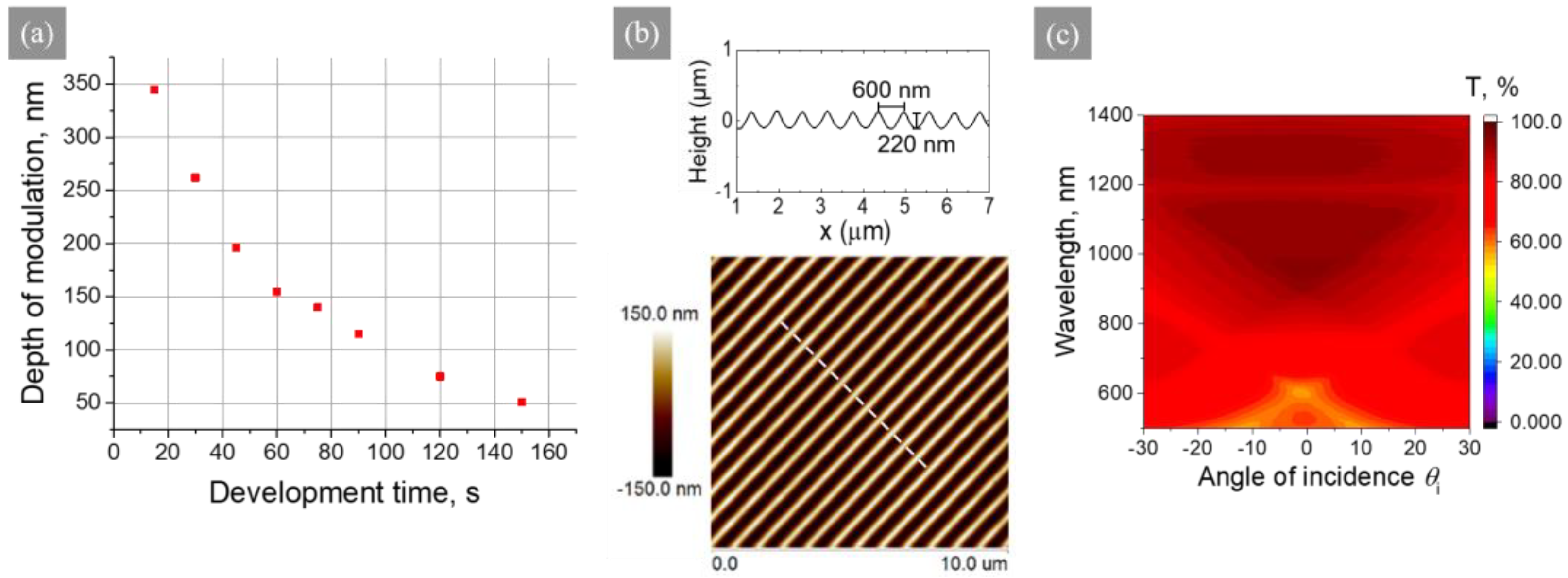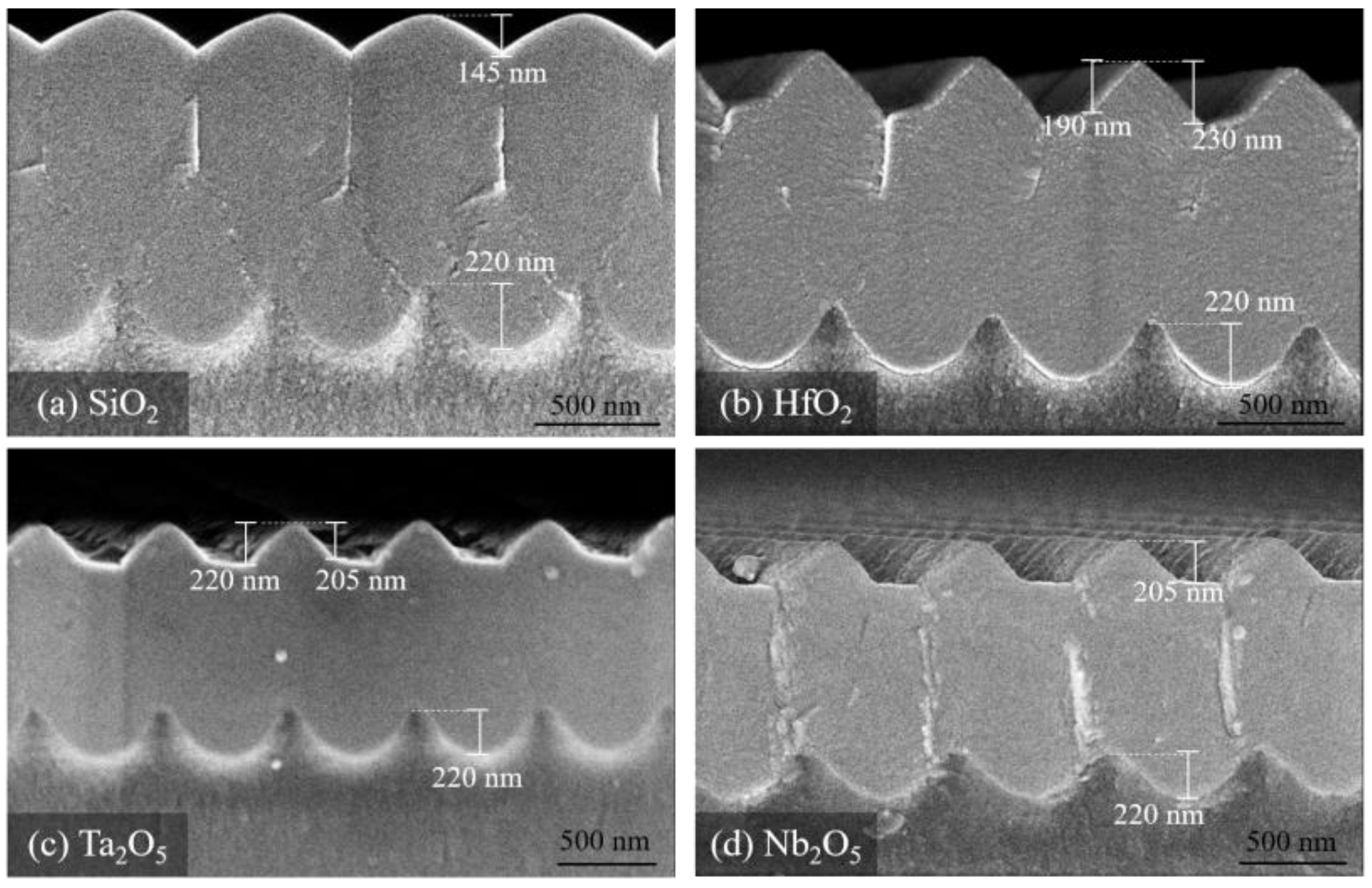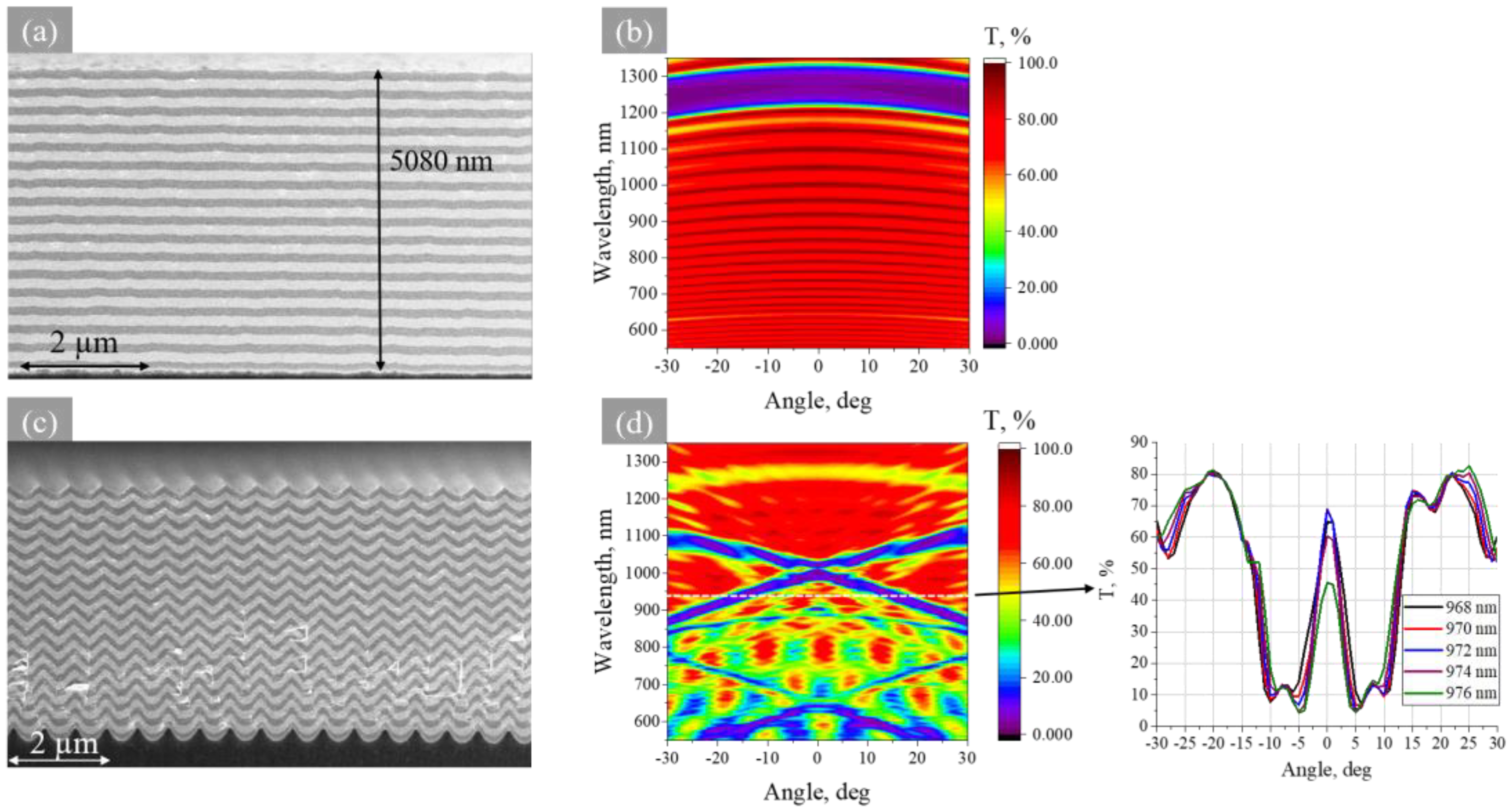Optical Coating Deposition on Submicron-Patterned Surfaces
Abstract
:1. Introduction
2. Materials and Methods
2.1. Fabrication of Modulated Substrates
2.2. Coatings Deposition Techniques
2.2.1. E-Beam with Glancing Angle Deposition
2.2.2. E-Beam with Plasma Assistance
2.2.3. Ion Beam Sputtering
2.2.4. Atomic Layer Deposition
2.3. Characterization
3. Results and Discussion
3.1. Investigation of Different Deposition Techniques
3.2. Structural Analysis of IBS Single-Layer Coatings
3.3. Optical Analysis
4. Conclusions
Author Contributions
Funding
Institutional Review Board Statement
Informed Consent Statement
Data Availability Statement
Acknowledgments
Conflicts of Interest
References
- Wang, P.Y.; Herrero, R.; Botey, M.; Cheng, Y.C.; Staliunas, K. Translationally Invariant Metamirrors for Spatial Filtering of Light Beams. Phys. Rev. A 2020, 102, 013517. [Google Scholar] [CrossRef]
- Lymarenko, R.A.; Gailevicius, D.; Meskelaite, I.; Grineviciute, L.; Peckus, M.; Staliunas, K.; Taranenko, V.B. Super-Collimation by Axisymmetric Diffractive Metamirror. Opt. Lett. 2021, 46, 3845. [Google Scholar] [CrossRef] [PubMed]
- Grinevičiūtė, L.; Andrulevičius, M.; Melninkaitis, A.; Buzelis, R.; Selskis, A.; Lazauskas, A.; Tolenis, T. Highly Resistant Zero-Order Waveplates Based on All-Silica Multilayer Coatings. Phys. Status Solidi 2017, 214, 1700764. [Google Scholar] [CrossRef]
- Mireles, M.; Hoffman, B.N.; MacNally, S.; Smith, C.C.; Lakshmanan, S.N.; Lambropoulos, J.C.; Rigatti, A.L.; Demos, S.G. Direct-Write Laser-Assisted Patterning of Form Birefringence in Wave Plates Fabricated by Glancing-Angle Deposition. Optica 2023, 10, 657. [Google Scholar] [CrossRef]
- Plukys, M.; Grineviciute, L.; Nikitina, J.; Gailevicius, D.; Staliunas, K. Enhancement of Brightness in Microchip Laser with Angular Filtering Mirrors. Opt. Laser Technol. 2025, 181, 111904. [Google Scholar] [CrossRef]
- Doucet, A.; Beydaghyan, G.; Ashrit, P.V.; Bisson, J.-F. Compact Linearly Polarized Ceramic Laser Made with Anisotropic Nanostructured Thin Films. Appl. Opt. 2015, 54, 8326. [Google Scholar] [CrossRef]
- Liu, R.; Cao, L.; Liu, D.; Wang, L.; Saeed, S.; Wang, Z. Laser Interference Lithography—A Method for the Fabrication of Controlled Periodic Structures. Nanomaterials 2023, 13, 1818. [Google Scholar] [CrossRef]
- Sebastian, E.M.; Jain, S.K.; Purohit, R.; Dhakad, S.K.; Rana, R.S. Nanolithography and Its Current Advancements. Mater. Today Proc. 2020, 26, 2351–2356. [Google Scholar] [CrossRef]
- Mehta, A.; Brown, J.D.; Srinivasan, P.; Rumpf, R.C.; Johnson, E.G. Spatially Polarizing Autocloned Elements. Opt. Lett. 2007, 32, 1935. [Google Scholar] [CrossRef]
- Sergeant, N.P.; Agrawal, M.; Peumans, P. High Performance Solar-Selective Absorbers Using Coated Sub-Wavelength Gratings. Opt. Express 2010, 18, 5525. [Google Scholar] [CrossRef]
- Grineviciute, L.; Nikitina, J.; Babayigit, C.; Staliunas, K. Fano-like Resonances in Nanostructured Thin Films for Spatial Filtering. Appl. Phys. Lett. 2021, 118, 131114. [Google Scholar] [CrossRef]
- Grineviciute, L.; Babayigit, C.; Gailevičius, D.; Peckus, M.; Turduev, M.; Tolenis, T.; Vengris, M.; Kurt, H.; Staliunas, K. Nanostructured Multilayer Coatings for Spatial Filtering. Adv. Opt. Mater. 2021, 9, 2001730. [Google Scholar] [CrossRef]
- Balonek, G. Coating a Grating Structure Using Various Deposition Techniques; University of Rochester, Institute of Optics: Rochester, NY, USA, 2013. [Google Scholar]
- Oliver, J.B.; Kessler, T.J.; Charles, B.; Smith, C. LLE Review; Quarterly Report; DOE/NA/1944-1170; University of Rochester, Laboratory for Laser Energetics: Springfield, VA, UAS, 2014; Volume 138, pp. 148–151. [Google Scholar]
- Oliver, J.B.; Kessler, T.J.; Charles, B.; Smith, C. Fabrication of a Continuous-Enfolded Grating by Ion-Beam–Sputter Deposition; SVC Techcon: Nashville, TN, USA, 2015; pp. 483–487. [Google Scholar]
- Yakovlev, N.N.; Almaev, A.V.; Kushnarev, B.O.; Verkholetov, M.G.; Poliakov, M.V.; Zinovev, M.M. β-Ga2O3 Schottky Barrier Diode with Ion Beam Sputter-Deposited Semi-Insulating Layer. Crystals 2024, 14, 123. [Google Scholar] [CrossRef]
- Henn, S.; Dornberg, G.; Müller, A.; Bundesmann, C.; Frost, F.; Sturm, C.; Grundmann, M. Optical and Structural Characterization of Zinc Oxide Thin Films upon Ion Beam Assisted Smoothing. Thin Solid Film. 2024, 794, 140290. [Google Scholar] [CrossRef]
- Kalanov, D.; Gerlach, J.W.; Bundesmann, C.; Bauer, J.; Lotnyk, A.; Von Wenckstern, H.; Anders, A.; Unutulmazsoy, Y. Heteroepitaxial Growth of Ga2O3 Thin Films on Al2O3(0001) by Ion Beam Sputter Deposition. J. Appl. Phys. 2024, 136, 015302. [Google Scholar] [CrossRef]
- Kawashima, T. Autocloning Technology: Fabrication Method for Photonic Crystals Based on Sputtering Process. In Proceedings of the AIP Conference Proceedings, Baltimore, MD, USA, 4–6 April 2001; AIP: Erice, Italy, 2001; Volume 560, pp. 115–122. [Google Scholar]
- Srinivasan, P. Design and Fabrication of Space Variant Micro Optical Elements. Master’s Thesis, University of Central Florida, Orlando, FL, USA.
- Ohtera, Y.; Onuki, T.; Inoue, Y.; Kawakami, S. Multichannel Photonic Crystal Wavelength Filter Array for Near-Infrared Wavelengths. J. Light. Technol. 2007, 25, 499–503. [Google Scholar] [CrossRef]
- Destouches, N.; Pommier, J.-C.; Parriaux, O.; Clausnitzer, T.; Lyndin, N.; Tonchev, S. Narrow Band Resonant Grating of 100% Reflection under Normal Incidence. Opt. Express 2006, 14, 12613. [Google Scholar] [CrossRef]
- Chen, S.-H.; Chen, C.-K.; Huang, Y.-C.; Lee, C.-C. Omni-Directional Reflectors for Deep Blue LED Using Symmetric Autocloning Method. Opt. Rev. 2013, 20, 141–144. [Google Scholar] [CrossRef]
- George, S.M. Atomic Layer Deposition: An Overview. Chem. Rev. 2010, 110, 111–131. [Google Scholar] [CrossRef]
- Pinna, N.; Knez, M. (Eds.) Atomic Layer Deposition of Nanostructured Materials, 1st ed.; Wiley: Hoboken, NJ, USA, 2011; ISBN 978-3-527-32797-3. [Google Scholar]
- Cremers, V.; Puurunen, R.L.; Dendooven, J. Conformality in Atomic Layer Deposition: Current Status Overview of Analysis and Modelling. Appl. Phys. Rev. 2019, 6, 021302. [Google Scholar] [CrossRef]
- Astrauskytė, D.; Galvanauskas, K.; Gailevičius, D.; Drazdys, M.; Malinauskas, M.; Grineviciute, L. Anti-Reflective Coatings Produced via Atomic Layer Deposition for Hybrid Polymer 3D Micro-Optics. Nanomaterials 2023, 13, 2281. [Google Scholar] [CrossRef] [PubMed]
- Bhattacharya, R.S.; Rai, A.K.; McCormick, A.W. Ion-Beam-Assisted Deposition of Al2O3 Thin Films. Surf. Coat. Technol. 1991, 46, 155–163. [Google Scholar] [CrossRef]
- RF Plasma Source, CCR GmbH. Available online: https://www.rf-icp-plasmasources.com/copra-products/copra-built-in-sources/copra-built-in-plasma-sources (accessed on 21 March 2025).
- Abromavičius, G.; Juodagalvis, T.; Buzelis, R.; Juškevičius, K.; Drazdys, R.; Kičas, S. Oxygen Plasma Etching of Fused Silica Substrates for High Power Laser Optics. Appl. Surf. Sci. 2018, 453, 477–481. [Google Scholar] [CrossRef]
- CEC GmbH. Operation Manual Deposition System “IBS@LAB”; Cutting Edge Coatings GmbH: Hannover, Germany, 2009. [Google Scholar]
- Abromavičius, G. Microstructural and Optical Properties of Metal Oxide Optical Coatings Deposited by Ion Beam Sputtering and Their Application in UV Spectral Range. Ph.D. Thesis, Vilniaus Universitetas, Vilnius, Lithuania, 2020. [Google Scholar]
- Kaufman, H. Applications of Broad-Beam Ion Sources; Kaufman & Robinson, Inc.: Fort Collins, CO, USA, 2011. [Google Scholar]
- Stenzel, O. Optical Coatings: Material Aspects in Theory and Practice; Springer Series in Surface Sciences; Springer: Berlin/Heidelberg, Germany, 2014; Volume 54, ISBN 978-3-642-54062-2. [Google Scholar]
- Çetinörgü-Goldenberg, E.; Klemberg-Sapieha, J.-E.; Martinu, L. Effect of Postdeposition Annealing on the Structure, Composition, and the Mechanical and Optical Characteristics of Niobium and Tantalum Oxide Films. Appl. Opt. 2012, 51, 6498. [Google Scholar] [CrossRef] [PubMed]
- Gabriel, N.T.; Talghader, J.J. Thermal Conductivity and Refractive Index of Hafnia-Alumina Nanolaminates. J. Appl. Phys. 2011, 110, 043526. [Google Scholar] [CrossRef]
- Gieraltowska, S.; Wachnicki, L.; Dluzewski, P.; Witkowski, B.S.; Godlewski, M.; Guziewicz, E. Atomic Layer Deposition of HfO2 Films Using TDMAH and Water or Ammonia Water. Materials 2023, 16, 4077. [Google Scholar] [CrossRef] [PubMed]
- Groner, M.D.; Fabreguette, F.H.; Elam, J.W.; George, S.M. Low-Temperature Al2O3 Atomic Layer Deposition. Chem. Mater. 2004, 16, 639–645. [Google Scholar] [CrossRef]
- Myers, T.J.; Throckmorton, J.A.; Borrelli, R.A.; O’Sullivan, M.; Hatwar, T.; George, S.M. Smoothing Surface Roughness Using Al2O3 Atomic Layer Deposition. Appl. Surf. Sci. 2021, 569, 150878. [Google Scholar] [CrossRef]
- Gerritsen, S.H.; Chittock, N.J.; Vandalon, V.; Verheijen, M.A.; Knoops, H.C.M.; Kessels, W.M.M.; Mackus, A.J.M. Surface Smoothing by Atomic Layer Deposition and Etching for the Fabrication of Nanodevices. ACS Appl. Nano Mater. 2022, 5, 18116–18126. [Google Scholar] [CrossRef]
- Lau, W.S.; Du, L.; Yu, D.Q.; Wang, X.; Wong, H.; Xu, Y. The Application of a Selective Etch to Conclusively Show the Surface Smoothing Effect of an Amorphous Thin Film Deposited by Atomic Layer Deposition. ECS J. Solid State Sci. Technol. 2017, 6, N111–N116. [Google Scholar] [CrossRef]
- Lau, W.S.; Zhang, J.; Wan, X.; Luo, J.K.; Xu, Y.; Wong, H. Surface Smoothing Effect of an Amorphous Thin Film Deposited by Atomic Layer Deposition on a Surface with Nano-Sized Roughness. AIP Adv. 2014, 4, 027120. [Google Scholar] [CrossRef]
- PubChem—An Open Chemistry Database at the National Institutes of Health (NIH). Available online: https://Pubchem.Ncbi.Nlm.Nih.Gov/#query=niobium (accessed on 21 March 2025).







| Material | Refractive Index at λ = 980 nm | O2 Flux, sccm | Partial Pressure, mbar | Physical Thickness, nm |
|---|---|---|---|---|
| HfO2 | 2.01 | 5 | 5.0·10−5 | 1000 |
| HfO2 | 1.94 | 80 | 1.4·10−4 | 1000 |
| SiO2 | 1.48 | 80 | 1.4·10−4 | 1000 |
| NbO2 | 2.24 | 80 | 1.4·10−4 | 1000 |
| Ta2O5 | 2.09 | 40 | 8.0·10−5 | 900 |
| Material | Molecular Weight, g/mol |
|---|---|
| Si | 28.09 |
| Hf | 178.49 |
| Ta | 180.95 |
| Nb | 92.90 |
Disclaimer/Publisher’s Note: The statements, opinions and data contained in all publications are solely those of the individual author(s) and contributor(s) and not of MDPI and/or the editor(s). MDPI and/or the editor(s) disclaim responsibility for any injury to people or property resulting from any ideas, methods, instructions or products referred to in the content. |
© 2025 by the authors. Licensee MDPI, Basel, Switzerland. This article is an open access article distributed under the terms and conditions of the Creative Commons Attribution (CC BY) license (https://creativecommons.org/licenses/by/4.0/).
Share and Cite
Grineviciute, L.; Melnikas, S.; Nikitina, J.; Drazdys, M.; Selskis, A.; Astrauskytė, D. Optical Coating Deposition on Submicron-Patterned Surfaces. Coatings 2025, 15, 372. https://doi.org/10.3390/coatings15040372
Grineviciute L, Melnikas S, Nikitina J, Drazdys M, Selskis A, Astrauskytė D. Optical Coating Deposition on Submicron-Patterned Surfaces. Coatings. 2025; 15(4):372. https://doi.org/10.3390/coatings15040372
Chicago/Turabian StyleGrineviciute, Lina, Simas Melnikas, Julianija Nikitina, Mantas Drazdys, Algirdas Selskis, and Darija Astrauskytė. 2025. "Optical Coating Deposition on Submicron-Patterned Surfaces" Coatings 15, no. 4: 372. https://doi.org/10.3390/coatings15040372
APA StyleGrineviciute, L., Melnikas, S., Nikitina, J., Drazdys, M., Selskis, A., & Astrauskytė, D. (2025). Optical Coating Deposition on Submicron-Patterned Surfaces. Coatings, 15(4), 372. https://doi.org/10.3390/coatings15040372






